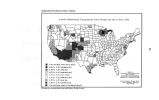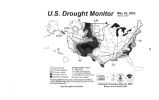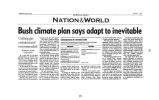| OCR Text |
Show 36 [ The prepared statement of Mr. Morgan follows:] PREPARED STATEMENT OF ROBERT L. MORGAN Utah's Water Situation 2002 and Beyond Current Drought Situation The entire State of Utah is experiencing drought conditions at the present time. For much of the state, snowpack is gone and streamflows that should be peaking now have fallen to drastically low levels. Statewide total reservoir storage is down 14 percent from last year and at about 75 percent of normal. This year, 2002, is the fourth consecutive year of below normal water supply. Last year's drought was more severe in the northern portion of the state, while this year's conditions are much drier in the southern portion of the state. Southern Utah has, with its normally dry climate, less reservoir storage than is found in the northern part of the state. Consequently, southern Utah is more susceptible to the impacts of drought. While statewide precipitation for the past year is about 78 percent of average, areas in the southern portion of the state have received only 20 percent to 30 percent of normal precipitation. Throughout the state most municipalities have taken steps to insure an adequate culinary water supply to meet future growth and projected water needs. These communities will survive the drought years with few problems. However, communities in southern Utah that rely on springs for their municipal water have marginal or inadequate water supplies. These communities are managing with outdoor water use restrictions. Utah's agricultural communities are suffering the greatest economic impacts from the drought. The agricultural industry operates with a smaller margin of error between supply and demand. Any shortage of agricultural water is keenly felt by agricultural producers. Drought Declarations San Juan County, in southeastern Utah, made a formal Drought Emergency Declaration on March 11, 2002. The county requested assistance from the State of Utah and Federal agencies, including the U. S. Bureau of Reclamation, Bureau of Land Management, the U. S. Forest Service and the U. S. Department of Agriculture. On March 26, 2002, the Navajo Nation, also located in San Juan County, made a formal Drought Emergency Declaration appealing to county, State and Federal agencies for assistance. On April 24, 2002 Governor Michael O. Leavitt of Utah signed an executive order ( Attachment C) declaring that: a " State of Emergency" and " Statewide Agricultural Disaster" exists throughout the State of Utah, and activated the state emergency operations plan. In the weeks that have followed, drought emergency declarations have been formally declared by the following counties: Iron, Piute, Grand, Washington, Carbon, Millard, Kane, Wayne, Daggett, Emery, Duchesne and Uintah. A complete chronological list of the counties' declarations and requests for assistance is included as Attachment A to this document. Another important issue is the possibility of disastrous wildfire in the watersheds. These fires would not only have and effect in this year but for years to come in the changing of the hydrologic characteristic of the watersheds leading to decreased water supplies. Response and Mitigation Efforts Prior to the Governor's formal Drought Emergency Declaration, the State Drought Response Plan was already in operation. The State Drought Review and Reporting Committee has met on a regular basis, since last summer, to be briefed on the statewide drought situation and discuss potential relief actions. With the Governor's formal drought emergency declaration, the Drought Response Committee was activated. This committee meets regularly to discuss drought impacts and coordinate response action. A drought committee meeting was held in Monticello, Utah, on May 13, 2002, to discuss possible mitigation and response measures that could be taken to reduce the impacts of the drought for San Juan County. In attendance at the meeting were representatives from Federal, State and local government agencies as well as representatives from the local farming, ranching, banking, real estate, commercial and industrial sectors. Some of the mitigation measures discussed at the meeting include: funding and drilling of wells to secure adequate water supplies for fire suppression, trucking in feed for cattle, and the opening up of Conservation Reserve Program Lands ( CRP) for grazing. |


























































































